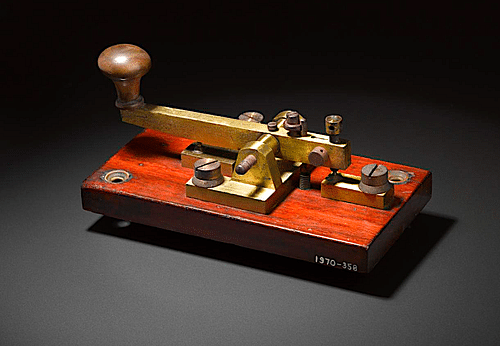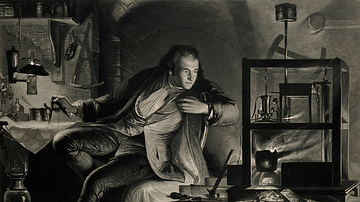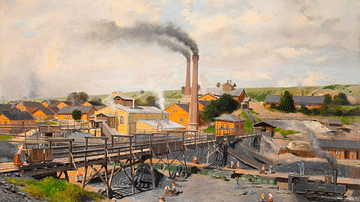
The British Industrial Revolution (1760-1840) brought innovative mechanisation and deep social change. The process saw the invention of steam-powered machines, which were used in factories in ever-growing urban centres. Agriculture remained important, but cotton textiles became Britain's top export, capital replaced land as an indicator of wealth, and the labour force diversified to include many more women and children.
Defining a 'Revolution'
Dating the precise beginning and end of the Industrial Revolution in Britain is problematic. Historians do not all agree on precise dates as the 'revolution' was not a single dramatic event or even a series of them, but, rather, a long and gradual process of mechanisation of industry and agriculture, which in turn caused a number of important and long-lasting social changes, chief amongst them being accelerated urbanisation across Britain. The generally agreed range of the mid-18th century to the mid-19th century is useful but misses important, even necessary developments beforehand (for example, the increased efficiency in agriculture) and the continuation of machine inventions (such as the telephone) afterwards. Research published in 2024 by the University of Cambridge focussed on occupations and supports a start date for the 'revolution' as some point in the 17th century.
The term 'industrial revolution', coined by the historian Arnold Toynbee in 1884, is misleading since this process of change was neither quick nor driven by popular uprisings. In addition, the word 'industrial' denies the importance of significant changes in rural life through this period. What is more certain is that the imperfect label 'Industrial Revolution' does capture the idea that tremendous changes occurred so that the countryside, cities, and working life of the late 19th century would have seemed incredible to a visitor from the late 16th century. The author Thomas Hardy (1840-1928) noted that the steam-powered railways alone, probably the most visible element of the 'revolution' for most people, brought more change than any other development since the Norman conquest of England in 1066.
The Industrial Revolution happened first in Britain, and so, when referring to that country alone, it is often called the First Industrial Revolution. Where this mechanisation and urbanisation spread to other countries, it is called the Second Industrial Revolution, for example, in France from 1830, Germany from 1850, and the United States from 1865.

Causes of the Industrial Revolution
The Industrial Revolution began in Britain for a number of reasons. There was an efficient agricultural system that could feed a booming population. With its coalfields, Britain had abundant cheap fuel and, in 1700, was already skilled in mining, producing 80% of the coal in Europe. Another knowledge advantage for Britain was the use of coke as a fuel to make high-quality iron. Coke is made from baking coal in a furnace to remove as many impurities as possible. The first working blast furnace employing coke was used in 1709 at Coalbrookdale in Shropshire, a works owned by Abraham Darby (1678-1717). Britain, then, had both the material to make machines and the fuel to power them even before the Industrial Revolution proper began.
Labour in Britain was relatively expensive because of the expanding agricultural system, which was now using more and more enclosed land (land requisitioned for farming from common land). Farms needed more labourers, but fewer were available as urbanisation developed, and so wages rose. This fact meant that inventors had a profit motive to design machines that could reduce labour. Capitalists were given favourable conditions by governments to invest in these inventions and Britain's trade empire, particularly that established by the East India Company, could be used to exploit such innovations by providing markets for manufactured goods. There was, too, a trend for people to leave the countryside to find work, and this was exploited and accelerated by business owners able to set up machine-based factories, particularly textile mills. Once the urbanisation ball was rolling at a certain pace, inventions accelerated the 'revolution' as more machines were invented to make even better machines, and so mechanisation surged on. The railways continued the process by creating even more demand for coal, iron, and steel. The pace of urbanisation increased further, and a new middle-class consumer market was created, which drove demand for more innovation and more products. While some other countries had some of these causal factors in place, none had as many as Britain.
Inventors & Machines
The Steam Engine
Water, wind, and muscle power had long been harnessed for heavy machinery such as windmills and waterwheels. These early machines allowed business owners to replace the old cottage industry model, where, for example, skilled weavers worked in their own homes, with a factory system where a number of unskilled workers lived on the premises and operated the machines. The catalyst for even greater change was the invention of the steam engine. Steam power was first developed so that pumps could drain mine shafts and allow deeper mining. The steam pump was patented in 1698 by Thomas Savery (c. 1650-1715). In 1710, Thomas Newcomen (1664-1729) adjusted Savery's design and made the machine more efficient. Newcomen's machine could suck 5,000 gallons (22.7 K litres) every hour out of a 153-foot (46.6 metres) deep mine shaft. The problem was the amount of fuel needed for the machine. In 1769, the Watt steam engine, designed by James Watt (1736-1819) with developments added by Matthew Boulton (1728-1809), answered the market's demand for a powerful engine that could be used anywhere. By 1800, Britain boasted over 2,500 steam engines, most of them used in mines, cotton mills, and factories. This compares to 200 engines in France and fewer than 10 in the USA. Other inventors came along and added to the power capabilities of the steam engine so that, by the 1830s, they could be used to drive trains and steamships.
Transportation
The steam-powered railways revolutionised travel and Britain itself. On 27 September 1825, the Locomotion 1 train invented by George Stephenson (1781-1848) transported the first railway passengers from Stockton to Darlington in the northeast of England. In 1829, George Stephenson's son, Robert Stephenson (1803-1859), created the Rocket, and he entered it in the Rainhill Trials. The Trials were competitions designed to find the best locomotive for use on the railway line connecting Manchester to Liverpool, which opened in 1830. In 1838, Birmingham was connected to London; in 1841, passengers could take the Great Western Railway line from the capital to Bristol. By 1845, there was a line from Manchester to London, which took eight hours of travel (the old stagecoaches would have taken 80 hours). The railways were booming. By the 1870s, there were over 15,000 miles (24,000 km) of rail lines, with trains carrying over 300 million passengers and over 150 million tonnes of goods each year.
Steam-powered shipping followed the trains. The engineer Isambard Kingdom Brunel (1806-1859) used a steam engine to power his giant ships the SS Great Western (1838), the innovative propellor-driven SS Great Britain (1843), and the SS Great Eastern (1858), the largest ship in the world at 692 feet (211 m) long. These ships and others crossed the Atlantic faster than ever before (10 days compared to 32 using just sail), and soon ambitious new routes to India and Australia were established.
Factories
From the 1790s, steam-powered machines were used with such success in the textile industry that by 1835 around 75% of cotton mills were using steam power. A series of machines had been invented which revolutionised how cotton was cleaned, spun, and woven. These devices were the flying shuttle (John Kay, 1733), spinning jenny (James Hargreaves, 1764), waterframe (Richard Arkwright, 1769), spinning mule (Samuel Crompton, 1779), power loom (Edmund Cartwright, 1785), cotton gin (Eli Whitney, 1794), and Robert's loom and self-acting mule (Richard Roberts, 1822-5). Because of the mechanised factory system, the British "cotton mill of 1836 was so efficient that it could out-compete hand spinning anywhere in the world" (Allen, 187).
Some people protested at the increasing mechanisation. The period between 1811 and 1816 was particularly problematic for factory owners. The Luddites broke into factories and smashed the machines that had taken away their livelihoods. However, in the longer term, many more jobs were created in the factories than had been available in the old cottage industries. By 1830, one in 80 Britons worked in a textile mill.
Agriculture
The Industrial Revolution is often described as a move from an agrarian society to an industrial one, but agriculture remained an important sector of the British economy. Farming expanded to meet a growing population through the process of enclosure. In 55 years from 1760 to 1815, over 7 million acres (28,300 km²) of British communal land was enclosed. Better fertilisers improved crop yields. New breeding methods improved livestock.
The mobility and fuel efficiency of the Watt steam engine meant that farmers could use various machines anywhere and precisely when they were needed. Andrew Rodgers invented the winnowing machine in 1737 (which separated the wheat from the chaff). In 1787, Andrew Meikle (1719-1811) invented the first steam-powered threshing machine (which separated the grain from the husk). Steam-powered machines could uproot trees that blocked fields and drain waterlogged areas to make them arable. Machine-made tools were cheaper, had better cutting edges, and lasted longer than previously. Mass production allowed farmers to repair their machines with spare parts, rather than replace them entirely.
All of these factors made food cheaper for everyone. British agricultural products, along with imports, were able to feed a population which had risen from 6 million in 1750 to 21 million in 1851. A downside was that as farming became more productive, rents rocketed, which meant many small-scale farmers were forced to move elsewhere or try a different profession. Just like the Luddites, some protested violently at mechanisation. The Swing Riots of 1830 to 1832 saw a short-lived spurt of machine wrecking in the countryside. While it was true that people left rural areas to find new work and new lives in cities, many remained. In 1841, "just over 1 in 5, 22 percent of the country's workforce, worked on the land" (Shelley, 44).
Other Inventions
Other important inventions during the Industrial Revolution included Harrison's marine chronometer, invented by John Harrison (1693-1776) in 1770, which allowed navigators to accurately measure longitude. The world's first cast iron bridge was built across the River Severn in Shropshire by Abraham Darby III (1750-89), opened to the public in 1781. Frederick Albert Winsor (1763-1830) demonstrated in London in 1807 his new invention of street lights which used coal gas, a tremendously useful substance that was also used for home heating and cooking. The milling machine was invented around 1818, but, typical of many inventions in this period where ideas were shared, borrowed, and stolen, it is difficult to pin down exactly who invented it. The machine cut pieces of metal like bolts and nuts that would have been near-impossible to do by hand. Portland cement was a fast-setting cement invented in 1824 by Joseph Aspdin (1778-1859). The telegraph machine was invented in 1837 by William Fothergill Cook (1806-1879) and Charles Wheatstone (1802-1875), and it revolutionised communication. The steam hammer was developed in 1839 by James Nasmyth (1808-1890) and allowed huge metal pieces to be uniformly bent, essential for large steam engines, bridges, and ships. Finally, the Bessemer converter, invented by Henry Bessemer (1813-1898) in 1856, allowed for a much cheaper production of steel, which is stronger and lighter than iron.
The Positive Impact of the Industrial Revolution
The impact of the British Industrial Revolution was dramatic. Steam-powered machines reduced production costs, made profits higher, and permitted mass-produced consumer goods to be cheaper. The transport revolution continued this trend because a single train could carry 20 times the cargo of a canal boat and reach its destination eight times faster. Mechanisation and the railways created a boom in the coal mining, iron, and steel industries. There was a whole raft of new jobs available, such as in the railway stations, on construction sites, and in the factories. Women gained more financial independence; women comprised over half the workforce in textile factories. Most people could afford a train excursion to the seaside once a year. The telegraph meant the speed of communication vastly increased.
Literacy improved thanks to the opportunities for basic schooling increasing and books becoming cheaper thanks to papermaking and printing machines. People in cities married younger and had more children. Life expectancy rose because of better diet and new vaccinations but much depended on a person's job, and infant mortality rates could be high in some periods.
The urban middle class expanded to around 25% of the population by 1800, and they were often able to live in the more pleasant leafy suburbs of cities. The middle classes could frequent the ever-increasing number of shops that stocked an increasingly wide range of goods from across Britain and its empire. They were enticed to spend their disposable income through new marketing strategies like mass advertising and elegant showrooms like those of the potter Josiah Wedgwood (1730-1795). The middle classes could employ servants and send their children to better schools or private tutors. The standard of living rose for most people during the Industrial Revolution, on average by around 30%, but only from the 1830s was this the experience of the lower classes.
The Negative Impact of the Industrial Revolution
The benefits of the 'revolution' came at a cost. Traditional industries like handweaving and stagecoaches were all but destroyed by the arrival of steam power. The demand for cheap labour was insatiable as the profit motive became more important to more business owners. From 1800 to 1850, children composed between 20-50% of the mining workforce, working on average from the age of eight. Exploited with lower pay but the same 12-hour shifts as adults, child labour was used in every industry. An 1851 commission found that "one-third of children under the age of 15 worked outside the home" (Horn, 57). These children too often lived short and uneducated lives.
The factories offered many new jobs, but much of the work was unskilled, dull, and repetitive. The pay was regular, but the working day was ruled by the clock. There was no minimum wage, salaries were not related to inflation, and employees faced the ever-present threat of instant dismissal. Factory workers had few transferable skills, and so they were stuck at their level of work. Further, opening a business now required significant capital to invest in machinery so that one's product could be competitively priced. In addition, in the factory system, where workers concentrated only on a specific part of the production process, workers had little sense of achievement in the finished article, something they might have done in the old domestic system where a worker worked alone on a single item.






A Gallery of 30 Industrial Revolution Inventions
For men, women, and children, factories were dangerous and unhealthy places. Cotton mills were always kept dark and damp to protect the cotton threads, a situation detrimental to the lungs of the workers. Mines had a similar hazard and others. Machines were dangerous and could cause serious injury when pieces broke off or when fast-moving parts trapped fingers and limbs. Factories were noisy, and workers often suffered from impaired hearing. The common use of toxic substances like lead and mercury was another health hazard. Managers imposed strict rules and dished out fines. Attempts to form trade unions met with a total ban from the government from 1799 and 1824. Gradually, there were reforms from the 1830s, and working conditions and workers' rights did improve as working days were limited to 10 hours and employers were obliged to pay more attention to hygiene and safety in the workplace.
Urbanisation greatly accelerated during the Industrial Revolution. The 1851 census revealed that, for the first time, more people were living in towns and cities than in the countryside. This trend caused unique problems. Cities became cramped, and workers often lived in cheap housing, with families sharing properties. The streets were polluted by a lack of sanitation. In 1837, 1839, and 1847, there were typhus epidemics. In 1831 and 1849, there were cholera epidemics. The air was polluted, too, with so many factories belching out smoke from their coal furnaces. Crime rose, although largely only petty crime, as the urban poor grew in number and escaping justice became easier in the anonymity of large cities. The state made a half-hearted attempt to help the unemployed by offering the workhouse, an institution that deliberately offered a worse life than even the lowest-paid labourer could gain in case it became an attractive alternative to employment. Despite all the problems, urbanisation continued so that by 1880 only 20% of Britain's population lived in rural areas, and land ownership was concentrated in just 5% of the population.
The Spread of the Industrial Revolution
Other countries caught up with Britain. Ideas in technology, industry, and farming easily crossed borders. Some countries with very cheap labour or expensive fuel had to wait until the machines became cheaper and more efficient. The spread of the railways was a good indicator of this process. In the United States, the first working railroad was completed in 1833 (New York to Philadelphia). The first railway line in Continental Europe was completed in Belgium in 1835 (Brussels to Malines). By 1870, Canada, Australia, India, and most of Europe had joined in the railway mania. So it was with other innovations. By the 20th century, whether directly or indirectly, few states in the world remained unaffected by the tentacles of 'progress' the Industrial Revolution put forth.









